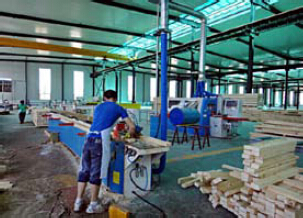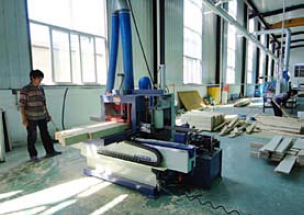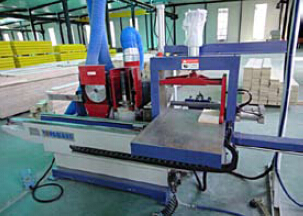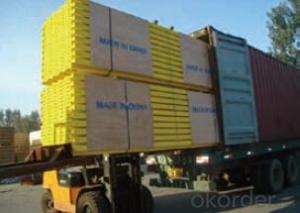Timber Beam H-20 for formwork and scaffolding systems
- Loading Port:
- Tianjin
- Payment Terms:
- TT OR LC
- Min Order Qty:
- 50 m²
- Supply Capability:
- 1000 m²/month
OKorder Service Pledge
Quality Product, Order Online Tracking, Timely Delivery
OKorder Financial Service
Credit Rating, Credit Services, Credit Purchasing
You Might Also Like
Characteristics:
◆ Standardized production lines.
Supply capability: 3000m/day, Lmax = 6600mm.
◆ Finger jointing of the flange and web, the strength of timber beam is highly improved.
Max. shearing force failure load:40KN
◆ Well treated to prevent from water penetration or erosion, so the service life maximally extended.
Normally, CNBM timber beam H20 can be used for 4 to 5 years, the exact using time would depend on maintenance & storage.
◆ Robust caps at the end of the girders protect against damages.




- Q:How does steel formwork affect the overall safety of a building project?
- Enhancing the overall safety of a building project is a crucial role that steel formwork plays. Its high strength and durability ensure a stable structure, preventing accidents such as collapses or structural failures that can cause serious injuries or fatalities. Furthermore, steel formwork offers a secure and dependable platform for workers. Its rigid structure minimizes the risks of slips, trips, and falls, which are common causes of accidents on construction sites. Additionally, safety features like handrails, guardrails, and non-slip surfaces can be incorporated into steel formwork designs, further enhancing worker safety. Another significant advantage of steel formwork is its fire-resistant properties. Unlike combustible materials, steel does not contribute to the spread of fire. This characteristic significantly reduces the potential for fire-related accidents, safeguarding both the workers and the structure itself. Moreover, steel formwork exhibits high resistance to adverse weather conditions, such as heavy winds, rain, or earthquakes. This resistance ensures the structure remains stable and secure even during extreme weather events, minimizing the risks of accidents or damage caused by these external factors. Lastly, steel formwork provides better quality control compared to other formwork materials. Its precise and consistent dimensions reduce the chances of errors or inconsistencies in the construction process, resulting in a safer and more reliable end product. In conclusion, steel formwork positively impacts the overall safety of a building project by providing stability, a secure working platform, fire resistance, weather resistance, and improved quality control. These factors collectively contribute to reducing the risks of accidents, injuries, and structural failures, making steel formwork an essential component in ensuring a safe construction environment.
- Q:What are the different types of formwork release agents used with steel formwork?
- There are several different types of formwork release agents that can be used with steel formwork. These agents are applied to the surface of the formwork before concrete is poured, helping to prevent the concrete from sticking to the steel and making it easier to remove the formwork once the concrete has cured. One common type of formwork release agent used with steel formwork is a petroleum-based release agent. This type of agent is made from a mixture of petroleum oils and other additives, and it provides a thin, lubricating film on the surface of the steel formwork. This film helps to reduce the friction between the formwork and the concrete, making it easier to remove the formwork without damaging the concrete surface. Another type of formwork release agent that can be used with steel formwork is a water-based release agent. This type of agent is typically made from a mixture of water, surfactants, and other additives. It forms a barrier between the steel formwork and the concrete, preventing the concrete from adhering to the surface of the formwork. Water-based release agents are often preferred in situations where environmental concerns or safety considerations make petroleum-based agents less desirable. In addition to petroleum-based and water-based release agents, there are also specialty formwork release agents available for use with steel formwork. These specialty agents may be designed for specific applications or to meet certain performance requirements. For example, there are high-performance release agents that are formulated to provide a superior release of the formwork, even in challenging conditions such as high temperatures or high humidity. There are also release agents that are specifically designed for use with certain types of concrete, such as self-consolidating concrete or high-strength concrete. Overall, the choice of formwork release agent for use with steel formwork will depend on factors such as the specific requirements of the project, environmental considerations, and personal preferences. It is important to carefully select the appropriate release agent and apply it correctly to ensure the successful removal of the formwork and the desired finish of the concrete surface.
- Q:Can steel formwork be used for both above-grade and below-grade walls?
- Steel formwork is a versatile construction tool that can be utilized for both above-grade and below-grade walls. Its adaptability allows for its use in various construction applications, encompassing both above-grade and below-grade walls. With its robustness and resilience, it is well-suited to endure the weight and pressure exerted by the concrete employed in these walls. Furthermore, the ease with which steel formwork can be assembled and disassembled facilitates efficient construction procedures for both wall types. Be it for basement walls or exterior walls above ground, steel formwork guarantees the essential support and shape for effective concrete pouring, ultimately yielding enduring and sturdy structures.
- Q:How does steel formwork handle different concrete pouring temperatures?
- Steel formwork is extremely durable and able to handle different concrete pouring temperatures with ease. The high strength and heat resistance properties of steel make it an ideal material for formwork in construction projects. When it comes to different concrete pouring temperatures, steel formwork remains stable and maintains its structural integrity. It does not warp or deform under extreme heat or cold, ensuring that the concrete retains its shape and structure during the pouring process. In hot weather conditions, steel formwork prevents rapid moisture loss from the concrete, which can lead to cracking and shrinkage. The steel acts as a barrier, reducing the impact of high temperatures on the concrete, and allowing it to cure properly. Similarly, in cold weather conditions, steel formwork helps to retain the heat generated during the concrete pouring process. This prevents freezing and ensures that the concrete sets and hardens correctly. The steel formwork also provides insulation, protecting the concrete from the harsh cold temperatures. Overall, steel formwork is highly adaptable and can withstand a wide range of concrete pouring temperatures. Its strength, durability, and resistance to heat and cold make it a reliable choice for handling different weather conditions during construction projects.
- Q:How does steel formwork affect the overall thermal insulation of a building?
- Steel formwork has minimal impact on the overall thermal insulation of a building. Since steel is a good conductor of heat, it does not provide sufficient insulation on its own. However, when combined with appropriate insulation materials, such as foam or mineral wool, steel formwork can contribute to a well-insulated building by providing structural support while the insulation material retains heat or cold temperatures.
- Q:How does steel formwork handle concrete curing additives?
- Steel formwork is a popular choice for concrete construction due to its durability and strength. When it comes to handling concrete curing additives, steel formwork is highly compatible and can effectively accommodate the use of such additives. Concrete curing additives, such as accelerators or retarders, are used to modify the setting and hardening time of concrete. These additives are typically added to the concrete mixture during the mixing process or applied to the surface of the formwork before pouring the concrete. Steel formwork is not adversely affected by the presence of curing additives in the concrete. It is resistant to chemical reactions and can withstand the potentially corrosive nature of certain additives. This ensures that the steel formwork remains structurally sound and maintains its integrity throughout the concrete curing process. Furthermore, steel formwork offers a smooth and non-porous surface, which allows for easy application and penetration of curing additives. This facilitates the even distribution of additives across the concrete surface, promoting consistent curing and optimal strength development. Moreover, steel formwork is reusable, which means that it can be used for multiple concrete pours. This reusability factor is particularly advantageous when working with concrete curing additives, as the formwork can be easily cleaned after each use, ensuring that no residue or build-up of additives remains on the surface. This helps to prevent any potential interference with subsequent concrete pours or compromising the quality of the cured concrete. In summary, steel formwork is well-suited for handling concrete curing additives. Its chemical resistance, smooth surface, and reusability make it an ideal choice for accommodating the use of curing additives, ensuring efficient and effective concrete curing.
- Q:How does steel formwork affect the overall aesthetics of a structure?
- Steel formwork can have a significant impact on the overall aesthetics of a structure. Unlike traditional wooden formwork, steel formwork provides a smooth and sleek finish to the concrete, resulting in a more visually appealing appearance. The use of steel formwork allows for precise and accurate shaping of the concrete, ensuring that the structure has clean lines and smooth surfaces. Furthermore, steel formwork enables architects and designers to create complex and intricate designs that would be difficult to achieve with other types of formwork. The strength and durability of steel formwork allow for the creation of unique shapes and patterns, enhancing the artistic value of the structure. In addition to its aesthetic benefits, steel formwork also offers practical advantages. It is reusable, making it a cost-effective option in the long run. The ability to reuse steel formwork reduces waste and promotes sustainable construction practices. Moreover, the durability of steel formwork ensures that the structure maintains its aesthetic appeal for years to come, as it is less prone to wear and tear compared to other formwork materials. Overall, steel formwork plays a crucial role in enhancing the overall aesthetics of a structure. It provides a smooth and clean finish, allows for intricate designs, and offers long-lasting durability. Architects and designers can rely on steel formwork to achieve their desired visual impact while ensuring structural integrity.
- Q:Can steel formwork be used for projects with complex geometries?
- Yes, steel formwork can be used for projects with complex geometries. Steel formwork offers high strength and durability, which makes it suitable for handling complex shapes and intricate designs. Steel formwork can be easily fabricated and customized to meet the specific requirements of the project, allowing for the creation of complex geometries without compromising on structural integrity. Additionally, steel formwork provides excellent dimensional stability, ensuring precise and accurate construction of complex shapes. The versatility and flexibility of steel formwork make it a preferred choice for projects that involve intricate and complex geometries.
- Q:How does steel formwork handle different concrete workability levels?
- Steel formwork is a flexible and long-lasting material that effectively handles various levels of concrete workability. Workability refers to how easily concrete can be mixed, placed, compacted, and finished. When dealing with different workability levels in concrete, steel formwork offers several advantages. Firstly, its sturdy and rigid structure can withstand the pressure exerted by concrete during pouring and compaction. This ensures that the formwork remains stable and does not deform or collapse under the weight of the concrete. Furthermore, steel formwork provides a smooth and uniform surface for the concrete, regardless of its workability. This is crucial for achieving a high-quality finish and minimizing defects like honeycombing or uneven surfaces. The smoothness of steel formwork allows for easy and efficient removal, ensuring that the concrete retains its shape and integrity. Moreover, steel formwork can be easily customized and adjusted to accommodate different workability levels. Its modular nature allows for easy assembly and disassembly, making it suitable for various construction projects and types of concrete. Steel formwork can be adjusted to fit changes in concrete consistency, ensuring that the formwork remains tight and secure. This adaptability is particularly beneficial when working with concrete mixes that have different slump values or consistencies. Another advantage of steel formwork is its reusability. Unlike other forms of formwork, such as wood or plastic, steel formwork can be used multiple times without compromising its structural integrity. This not only reduces construction costs but also allows for efficient handling of concrete with different workability levels. Steel formwork can be easily cleaned, repaired, and reused, making it a cost-effective and sustainable choice for handling various levels of concrete workability. In conclusion, steel formwork provides a dependable and flexible solution for handling different levels of concrete workability. Its strength, smoothness, adjustability, and reusability make it an ideal choice for ensuring the stability, quality, and efficiency of concrete construction projects.
- Q:Can steel formwork be used for tunnel portals?
- Yes, steel formwork can be used for tunnel portals. Steel formwork is a versatile and durable option for constructing tunnel portals due to its strength and ability to withstand the forces and pressures exerted by the surrounding soil and rock. Steel formwork can be fabricated to any shape and size required for tunnel portals and can be easily assembled and disassembled, making it a practical choice for tunnel construction. Additionally, steel formwork provides a smooth surface finish, which is important for tunnel portals as it allows for efficient flow of traffic and reduces the risk of damage to vehicles. Overall, steel formwork is a suitable and commonly used method for constructing tunnel portals.
1. Manufacturer Overview |
|
|---|---|
| Location | |
| Year Established | |
| Annual Output Value | |
| Main Markets | |
| Company Certifications | |
2. Manufacturer Certificates |
|
|---|---|
| a) Certification Name | |
| Range | |
| Reference | |
| Validity Period | |
3. Manufacturer Capability |
|
|---|---|
| a)Trade Capacity | |
| Nearest Port | |
| Export Percentage | |
| No.of Employees in Trade Department | |
| Language Spoken: | |
| b)Factory Information | |
| Factory Size: | |
| No. of Production Lines | |
| Contract Manufacturing | |
| Product Price Range | |
Send your message to us
Timber Beam H-20 for formwork and scaffolding systems
- Loading Port:
- Tianjin
- Payment Terms:
- TT OR LC
- Min Order Qty:
- 50 m²
- Supply Capability:
- 1000 m²/month
OKorder Service Pledge
Quality Product, Order Online Tracking, Timely Delivery
OKorder Financial Service
Credit Rating, Credit Services, Credit Purchasing
Similar products
New products
Hot products
Related keywords























